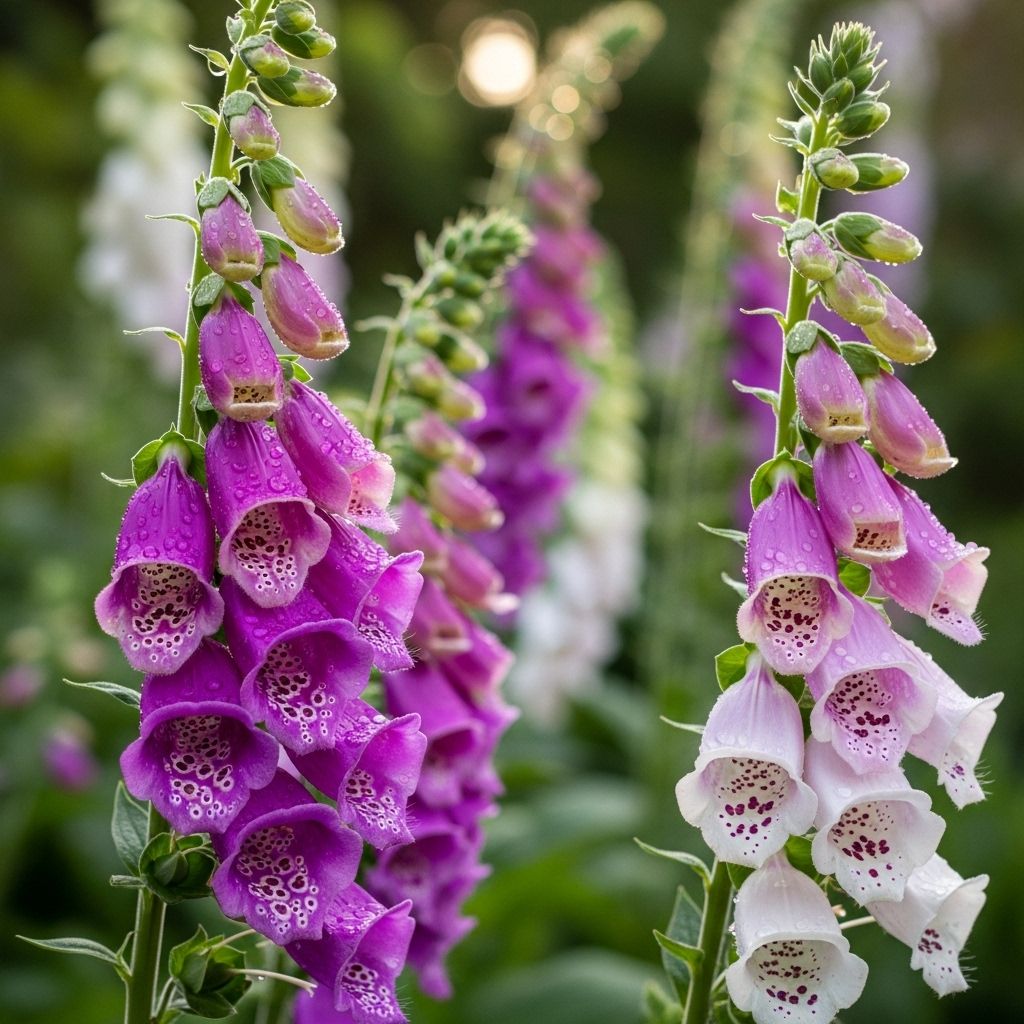Garden Decoder: Biennials Explained—The Mysterious Life of Foxgloves
Embrace nature’s pace with smart sowing and seed-saving for continuous garden color.

Image: HearthJunction Design Team
Annuals, Biennials, and Perennials: The Basics
Gardeners are often met with terms like annual, biennial, and perennial that describe different types of plants based on their life cycles. Understanding this terminology is key to planning a thriving garden, and few plants illustrate the quirks of these life cycles better than foxgloves.
- Annuals complete their life cycle in one year: from germination to growth, flowering, seed production, and death, all within a single season.
- Biennials require two years to complete their life cycle, typically growing foliage the first year and flowering in the second.
- Perennials live for more than two years, often blooming numerous times over their lifespans.
The mysterious nature of biennials—especially Digitalis purpurea (foxgloves)—can baffle even experienced gardeners. Let’s decode their special role in your landscape.
What is a Biennial? Understanding Their Two-Year Life Cycle
Unlike annuals and perennials, biennials unfold in two distinct acts:
- Year One: The plant grows a leafy rosette near the ground and focuses on establishing strong roots and foliage.
- Year Two: With the return of spring, the plant enters its reproductive phase, sending up tall flower spikes, producing seeds, and then dying back completely.
This two-year routine can confuse gardeners expecting immediate blooms. If you plant a biennial from seed, patience is key—their dramatic floral show usually arrives the year after sowing. This life pattern gives them their charming unpredictability, but also means that without careful planning, gardens can experience gaps in color from year to year.
Foxgloves: The Quintessential Biennial
With elegant, bell-shaped blossoms cascading along tall stems, foxgloves hold a special place in cottage and woodland gardens. Their beauty, resilience, and surprise appearances make them a perennial favorite (ironically, although they’re mostly biennial).
- Common species, like Digitalis purpurea, act as classic biennials: first a tight rosette, then a skyward flower spike in year two.
- Some varieties—such as Digitalis ferruginea—are short-lived perennials, retaining foliage year-round and occasionally blooming more than once.
But just when you think you’ve figured them out, foxgloves can spring up in new places thanks to their enthusiastic self-seeding habits.
“Foxgloves behave like a bad boyfriend. Owing to their biennial nature and a tendency to self-sow freely, foxgloves usually don’t show up when or where you expect them. After they’ve trained you not to rely on them, suddenly you find them standing by the front door, turning on the charm.” —Gardenista
Growing and Maintaining Biennial Foxgloves
Biennial foxgloves reward patience and a gentle hand in the garden. To ensure a constant parade of color and fewer barren years, gardeners must understand their rhythms and quirks.
How to Sow and Care for Foxglove Biennials
- Sowing Seeds: Sow foxglove seeds in summer. Either start them indoors in trays or scatter them directly into lightly cultivated soil.
- Transplanting: Move young seedlings to their final flower bed in fall, so they establish roots and form a robust rosette before winter.
- Winter Dormancy: Foxgloves tolerate cold and often survive light frosts in their first-year rosette phase.
- Blooming: Expect towering flower spikes the following summer, often 4–6 feet tall with cascading, spotted bells in shades of pink, purple, white, and yellow.
Ensuring Repeat Blooms
- Staggered Plantings: Sow seeds annually to guarantee each year features some foxglove blooms.
- Self-Seeding: Allow some foxglove stalks to set seed. Foxglove seeds are tiny and easily spread by wind and water, leading to delightful (though sometimes inconvenient) surprises in future seasons.
- Deadheading: If you prefer order, remove spent flower stalks before seeds mature; if you want more foxgloves, leave stalks standing until seeds are released.
- Soil and Water: Rich, well-drained soils and ample irrigation encourage taller, more floriferous foxgloves.
Table: Foxglove Life Cycle Overview
| Year | Growth Stage | Gardener Tasks |
|---|---|---|
| Year 1 | Seedling/Rosette | Sow seeds, nurture seedlings, establish in garden beds |
| Winter | Dormancy | Mulch lightly if needed; minimal intervention |
| Year 2 (Spring/Summer) | Flowering and Seeding | Watch for blooms, deadhead for tidiness or allow to seed for naturalizing |
| End of Year 2 | Completion | Collect seeds; remove dead plants |
Are All Foxgloves Biennial?
The majority of foxgloves found in borders—those with classic spires of purple, pink, or white flowers—are biennial. Some, such as Digitalis ferruginea, are classified as perennial or semi-evergreen, potentially returning for several years if conditions are ideal.1 However, for most garden varieties, expect the familiar two-year voyage from seed to bloom to demise.
- Always check labels or plant guides for your chosen foxglove variety’s habits.
- If you want repeat performers, mix in some perennial foxglove species with your biennials.
Buying Biennials: What to Expect from Nurseries
Most biennials sold at garden centers are in their second year and ready to bloom—meaning they’ll flower beautifully the season you bring them home, then die back rather than return the next year.4 If you want the full biennial experience, start your own from seed and plan for that one-year lag between planting and flowering.
- Pro: Instant color in your garden the year you purchase!
- Con: The plant is at the end of its life cycle; to ensure ongoing blooms, begin your own biennial succession from seed.
Foxglove Surprises: Why Didn’t They Return?
It’s not uncommon for gardeners to lament that foxgloves have “vanished” the year after a dazzling bloom. This isn’t failure or “black thumb” syndrome—it’s merely the plant’s two-year rhythm. If you don’t also have first-year rosettes in the ground, there will be no second-year bloomers.
- Self-seeding isn’t always guaranteed—weather, soil disturbance, and hungry wildlife can all affect success.
- To keep your display going, deliberately sow seeds and don’t rely solely on nature taking its course.
Design Tips: Using Foxgloves in the Garden
Foxgloves’ tall spikes add drama and height, making them ideal for the backs of borders, cottage gardens, and wildflower meadows.
- Clump Plantings: Plant in drifts or groups for striking visual impact.
- Nooks and Crannies: These opportunists will colonize tiny garden spaces, often germinating in cracks, at the base of walls, or between stepping stones.
- Color Play: Enjoy unexpected color variations—foxgloves can sometimes surprise you with hue shifts when they self-seed.
- Cut Flowers: Foxglove stems make marvelous, long-lasting cut flowers for dramatic bouquets.
Sowing, Saving, and Sharing Seeds
Experienced gardeners and beginners alike can easily save foxglove seeds to maintain a biennial cycle.
- When to Harvest: Collect seeds in late summer when seedpods dry and turn brown.
- How to Harvest: Snip the dry stalks, strip seeds into a paper envelope or jar, and store in a cool, dry place until next spring.
- Sowing: Lightly press seeds into the soil’s surface—do not bury, as they need light to germinate.
- Timing: Start seeds indoors in late winter/early spring or direct sow in late summer for blooms the following year.
Common Challenges and Solutions
- Erratic Bloom Locations: Foxgloves self-seed wherever they find a niche. Embrace the element of surprise, or transplant seedlings to more desirable spots.
- Inconsistent Returns: If a year passes with few or no foxglove blooms, it’s likely due to a planting gap. Maintain overlapping generations by annual sowing.
- Bee Stings: These blooms attract pollinators—be mindful in areas near outdoor seating!
- Toxicity: All parts of foxgloves are toxic if ingested—use caution with children and pets.
Frequently Asked Questions (FAQs)
Q: Are all foxgloves biennial?
A: Most garden foxgloves are biennials, completing their cycle across two years, but some species act as perennials. Always check variety details.
Q: Why didn’t my foxgloves return this year?
A: Most likely, there were no first-year rosettes left to bloom. It’s essential to keep sowing seeds each year to maintain a blooming rotation in your garden.
Q: Can I buy young foxglove plants and expect them to flower next year?
A: Most nursery plants are sold in their second, flowering year. To enjoy full cycles, start from seed and stagger planting times.
Q: Are foxgloves invasive?
A: Foxgloves self-seed prolifically but are not usually considered invasive. Unwanted seedlings can be easily removed or transplanted.
Q: How do I keep a continuous display of foxgloves?
A: Sow new foxglove seeds annually to ensure overlapping generations. Leave some flower stalks for self-seeding, or deliberately plant seeds every summer.
Conclusion: Embrace the Magic (and Mystery) of Biennials
Biennials like foxgloves add enchantment and surprise to the garden, rewarding patience and a bit of planning with spectacular floral displays. By understanding their unique two-year journey, sowing seeds regularly, and embracing their colorful unpredictability, you can enjoy a vibrant, ever-changing tapestry in your borders for years to come.
References
- https://www.homesandgardens.com/gardens/what-to-do-with-foxgloves-after-they-finish-flowering
- https://provincetownindependent.org/farm-garden/on-the-landscape/2025/07/02/the-bewildering-beauty-of-foxgloves/
- https://www.gardenista.com/posts/foxgloves-digitalis-purpurea-rethinking-a-fickle-flower/
- https://www.gardenista.com/posts/garden-decoder-biennials-explained-foxgloves/
- https://www.frenchcountrycottage.net/cottage-garden-foxgloves/
Read full bio of medha deb












